Super User
China to lead Asia LNG regasification capacity additions through 2025, forecasts GlobalData
China is expected to lead the Asia’s LNG regasification capacity additions, contributing 36% of the total LNG regasification capacity additions between 2021 and 2025, forecasts GlobalData, a leading data and analytics company.
GlobalData’s report, ‘Asia Capacity and Capital Expenditure Outlook for LNG Regasification Terminals, 2021–2025 –China Dominates LNG Regasification Capacity Additions and Capex Spending in Asia’, reveals that China is expected to add a new- build LNG regasification capacity additions of 4,380 bcf (billion cubic feet) by 2025, while the expansion projects account for the rest with 1,576 bcf.
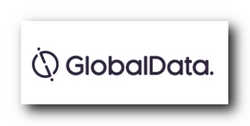 Bhargavi Gandham, Oil and Gas Analyst at GlobalData, comments: “Among the new build and expansion projects that are likely to start operations in China during the forecast period, Tangshan II is the largest upcoming project with a capacity of 584.4 bcf. Yantai I and Zhoushan III are the other major projects with capacities of 487 bcf and 340.9 bcf, respectively.”
Bhargavi Gandham, Oil and Gas Analyst at GlobalData, comments: “Among the new build and expansion projects that are likely to start operations in China during the forecast period, Tangshan II is the largest upcoming project with a capacity of 584.4 bcf. Yantai I and Zhoushan III are the other major projects with capacities of 487 bcf and 340.9 bcf, respectively.”
GlobalData identifies India to be the second-highest contributor to the global LNG regasification capacity additions with new build LNG regasification capacity additions of 3,062 bcf by 2025. Expansion projects account for the rest of the capacity additions with 365 bcf by 2025. Kakinada GBS Floating leads LNG regasification capacity additions in the country with a capacity of 350.6 bcf by 2025.
Pakistan is expected to be the third largest contributor to the LNG regasification capacity additions in India with 1,752 bcf. Of these, new build capacity additions account for 1,697 bcf. Among the new build projects in the country, Port Qasim is the largest upcoming project with a capacity of 438 bcf and is expected to start operations in 2023.
- Comments provided by Bhargavi Gandham, Oil & Gas Analyst at GlobalData
- Information based on GlobalData’s report: ‘Asia Capacity and Capital Expenditure Outlook for LNG Regasification Terminals, 2021–2025 – China Dominates LNG Regasification Capacity Additions and Capex Spending in Asia’
- Announced/Planned: Denotes only new-build assets that are in different stages of development and have not started commercial operations
- A new-build project that has not received relevant/ required approvals to develop/build the project is considered as Announced
- A new build project that has received relevant/ required approvals from the national government/ energy ministry/ regulatory authority/ local environmental authority/ port authority/local government, etc to develop/build the project is considered as Planned
- Expansion – Denotes capacity expansion of existing/operational terminal
- This report was built using data and information sourced from proprietary databases, primary and secondary research, and in-house analysis conducted by GlobalData’s team of industry experts
About GlobalData
4,000 of the world’s largest companies, including over 70% of FTSE 100 and 60% of Fortune 100 companies, make more timely and better business decisions thanks to GlobalData’s unique data, expert analysis, and innovative solutions, all in one platform. GlobalData’s mission is to help our clients decode the future to be more successful and innovative across a range of industries, including the healthcare, consumer, retail, technology, energy, financial and professional services sectors.
Farming not housing should be limited to reduce river nutrient levels
Housebuilding in regions close to rivers is on hold because developers are being asked to fix the problem of high nutrients in the water before planning approval can go ahead.
Savills has calculated 32 local authorities are affected resulting in 33,700 fewer homes being built a year in England and around 500 in Wales.
National Federation of Builders head of housing and planning policy Rico Wojtulewicz said: "Developers should not be paying for the cost of others impacts but as per usual, housebuilders are treated as a cash cow by the government both in financial and delay terms.
"Water companies need to invest in solutions, farmers need help to reduce their impacts and we will continue innovating to reduce any minimal impact we may have."
The issue stems from a European Court of Justice ruling in 2018 on the habitats' directive requiring special protection areas to comply with EU legislation on limits on nutrients in water. Too many nutrients fuel excessive algae growth depleting rivers of oxygen and damaging wildlife.
Natural England has advised 20 councils that permission cannot be legally granted for developments unless they are nitrate and phosphate neutral.

Key regions will be unable to meet housing need
South Hampshire and the Isle of Wight was the first region to receive this guidance in 2019 and now has a ‘nitrogen credit' scheme where developers can offset their nutrient footprint. They can do this by creating new wetlands, meadows and woodland to help stop nitrates from running off into the Solent.
Savills estimates a fall of 50 to 70 per cent in new homes being built in the region causing a tightening land market and limiting the area's potential to meet housing needs.
The building industry believes one of the most effective ways to reduce nitrates is for the government to limit intensive farming in areas close to rivers.
In north Herefordshire, 1,650 homes are under a planning moratorium due to high nutrient levels in the River Wye.
Local bespoke builder Border Oak argues intensive poultry farming is the major culprit for polluting the River Wye with nitrates and phosphates from fertiliser and chicken excrement.
Border Oak director Merry Albright said: "The majority of nutrients don't come from housing but agriculture. There's a huge disconnect with what is actually happening."
She added that Herefordshire was one of the largest intensive poultry producers in England with 20m chickens outnumbering the county's population of 192,000.
Neighbouring county Powys is estimated to be the largest poultry producer in Europe according to the Campaign for Protection of Rural England.
Currently half of the local authorities across Wales are halting planning applications after Natural Resources Wales set stricter limits for acceptable phosphate levels in rivers in January.
Ms Albright argues the UK government should take a similar approach to the Netherlands where they passed legislation to divest sensitive catchment areas from intensive livestock farming.
Brokers Hank Zarihs Associates said development finance lenders could offer SME housebuilders facing planning delays a range of funding options.
Climate case for wood
New manifesto calls for greater use of wood to help nations decarbonise
An international Wood Manifesto setting the future roadmap for timber and wood use in construction and other products was launched in the UK last week just ahead of the COP26 climate talks. The document seeks to convey that wood is the key material to decarbonise the built environment both quickly and at scale.
Emissions from the built environment come from two main sources: the energy we consume within buildings for heating, cooling and power (operational emissions) and the emissions associated with the extraction, processing and manufacture of building products (embodied emissions).
The Manifesto “Growing Our Low-Carbon Future: Time for Timber” is a collaboration of work led by the global wood industry’s COP26 International Partners Advisory Body as well as the European Confederation of Woodworking Industries and the European Organisation of the Sawmill Industry, as well as other international partners.
David Hopkins, Chief Executive of the Timber Trade Federation, said, “Going into COP26 the case for embracing the forest and timber industries has never been stronger or more urgent. Wood products can create better livelihoods for millions, and a built environment which works in harmony with nature.”
Roy Southey, executive director of Sawmilling South Africa, agrees that the world can make greater use of sustainable wood to transform the built environment, which is currently responsible for approximately 40 per cent of global energy related CO2 emissions. “South Africa is ripe for scaling up the use of timber in construction however many people perceive wood as rudimentary or weak. But for engineering professionals and architects of mass timber structures, there is significant opportunity for innovation, localisation and employment creation.”
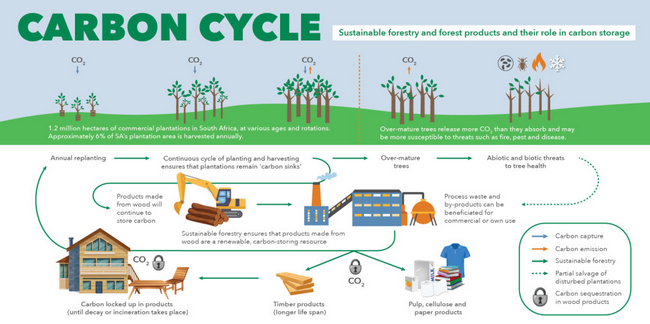
“The new Wood Manifesto will be a key step in not only finding new ways to use an age-old material that stores carbon but that also supports economies and livelihoods and provides everyday products,” concludes Southey.
“The increased use of wood and fibre-based products from sustainably managed plantations and forests will be key in combating climate change this century,” says Jane Molony, executive director of the Paper Manufacturers Association of South Africa, who will also be chairing a side-event on this topic at COP on 11 November.
The largest sustained mitigation benefit will be achieved through a sustainable forest management strategy that maintains or increases forest carbon stocks, while producing an annual sustained yield of timber, fibre or biomass. “This is exactly how our local forestry sector has operated for decades,” asserts Molony, adding that multiple trees are planted for every one which is harvested.
“From construction of mid- and high-rise buildings to single-use plastic replacements made from paper and cardboard, wood is a wonder fibre,” Molony said.
Wood is a naturally renewable material which:
- Sequesters carbon in forests and timber plantations as trees grow.
- Stores carbon in harvested wood products such as timber structures, pulp and paper.
- Substitutes for carbon intensive materials such as steel, concrete and plastics.
- Drives sustainable forest management leading to greater growth.
- Contributes to a circular economy as wood products can be reused, recycled, and recovered for low-carbon energy at end-of-life.
The manifesto was launched on 28 October, during the Royal Institute of British Architect’s Built Environment Summit to a global audience. Speaking at the launch of Time for Timber, Andrew Waugh of Waugh Thistleton Architects said, “Wood and wood-based materials offer solutions based on existing business models and proven technology. This is ‘carbon capture and storage’ in action now – with no further research or technological breakthroughs needed.
The five recommendations included in the report seek to rapidly scale up global forestry and timber industries and enhance the ability of the supply chain to minimise CO2 emissions across the lifecycle of any wood product:
- Embed mandatory lifecycle assessments and embodied carbon thresholds within local and national building plans.
- Increase the use of wood within new builds and renovations.
- Drive the growth of the bio-based circular economy through sustainable public procurement.
- Facilitate resource efficient use of wood, paper and recycling, especially collection and sorting in municipalities, and develop measures to gain access to post-consumer fibre, an invaluable secondary raw material resource.
- Increase training to upskill workers and create new jobs to boost the development of a sustainable and circular bioeconomy.
Crowley Charters Cleaner, More Powerful Compact Tier IV Ship Assist Tug
Crowley’s ship assist and escort services group has agreed to charter its third Tier IV ship assist tug, Athena.
Athena meets U.S. EPA Tier IV requirements for emissions control technology. The vessel will be equipped with remote monitoring for the improved efficiency of vessel operations and data exchange to further the company’s commitment to reducing the carbon footprint of its fleet.
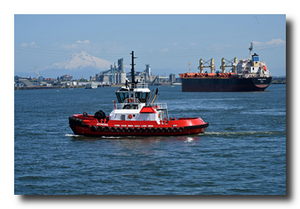 “Athena will provide innovation and performance for customers in the Pacific Northwest,” said Paul Manzi, vice president, Crowley Shipping. “The first two tugs produced by Diversified Marine and Brusco Tug & Barge have delivered high value and performance to our fleet. They provide a remarkable amount of power in a small footprint while reducing fuel burn and qualifying for Tier IV emissions performance rating.”
“Athena will provide innovation and performance for customers in the Pacific Northwest,” said Paul Manzi, vice president, Crowley Shipping. “The first two tugs produced by Diversified Marine and Brusco Tug & Barge have delivered high value and performance to our fleet. They provide a remarkable amount of power in a small footprint while reducing fuel burn and qualifying for Tier IV emissions performance rating.”
Athena follows sister ships Hercules and Apollo from builder Diversified Marine and owner Brusco Tug & Barge. The 77-foot Athena will feature almost 400 more horsepower than Apollo to deliver a bollard pull up to 96 tons, making it the most powerful tug for its size in the U.S.
“Athena is going to be a head-turner in the industry,” said Frank Manning, director of business development at Diversified Marine. “We’re proud of the incredible Hercules Class vessels our partnership with Brusco and Crowley has produced. We’ve worked closely with Crowley to incorporate operator feedback into each build while increasing horsepower on each tug. Athena will be an excellent boat, and we’re excited to see it working for a forward-thinking company like Crowley.”
Slated to operate in Puget Sound, Athena is currently under construction and is expected to be complete at the close of 2021.
About Crowley
Crowley Maritime Corporation is a privately held, U.S.-owned and -operated maritime, energy and logistics solutions company serving commercial and government sectors with more than $2.5 billion in annual revenues, over 160 vessels mostly in the Jones Act fleet and approximately 6,300 employees around the world – employing more U.S. mariners than any other company. The Crowley enterprise has invested more than $3 billion in maritime transport, which is the backbone of global trade and the global economy. As a global ship owner-operator and services provider with nearly 130 years of innovation and a commitment to sustainability, the company serves customers in 35 nations and island territories through four business units: Crowley Logistics, Crowley Shipping, Crowley Solutions and Crowley Fuels. Additional information about Crowley, its business units and subsidiaries can be found at www.crowley.com.
Vattenfall joins First Movers Coalition and commits to purchase low carbon products and technologies
First Movers Coalition was launched at COP26 in Glasgow by the U.S. State Department and the World Economic Forum. Vattenfall has joined as a founding member and is thereby committing to increasing the share of emerging technologies critical to the net-zero transition in its procurements.
“If we across industries can create a strong demand for new technologies that need to be developed in order to significantly reduce CO2-emissions in some of the most difficult sectors, that can speed up commercialisation of these products and thereby be essential to reach the 1.5 degree target. This is fully in line with Vattenfall’s strategy to make fossil free living possible within one generation and I am very optimistic about the future of this initiative,” says Anna Borg, President and CEO, Vattenfall.
U.S. Special Presidential Envoy for the Climate, John Kerry, has together with the World Economic Forum initiated the First Movers Coalition. It focuses on eight sectors that today comprise more than 30% of global CO2-emissions and where new technologies are needed to reduce emissions. In a first phase, commitments within four sectors have been presented and the joining companies commits to purchase shares by 2030 in one or more of these sectors.

Vattenfall has committed to:
- Put requirements towards its suppliers to use “breakthrough steel” that will enable the company to have at least 10% of the steel volumes procured annually by 2030 being breakthrough steel, like for example the Hybrit fossil free steel.
- Put requirements on its trucking service providers to meet the requirements of at least 30% of their heavy-duty and 100% of their medium-duty truck purchases being zero-emission trucks by 2030.
- Put requirements on airlines and air transport providers to replace at least 5% of conventional jet fuel demand with SAF (Sustainable Airline Fuels) that reduces life-cycle GHG emissions by 85% or more when compared with conventional jet fuel, and/or use zero-carbon emitting propulsion technologies by 2030.
Vattenfall has already committed to reduce the CO2 emissions from our business travel by air by 50% 2019-2022 and to make Vattenfall’s car fleet fossil free primarily via electrification.
“At the same time as we commit on increasing the share of low-carbon products and services that we buy, we are actively working in partnerships to develop these technologies, like for example with SSAB and LKAB in the Hybrit initiative for fossil free steel, and as we announced yesterday with SAS, Shell and LanzaTech to investigate large scale production of sustainable air fuel. Altogether we see big business opportunities in driving the transition towards a fossil free future,” says Anna Borg.
Facts:
Founding members are:
A.P. Møller –Mærsk
Aker ASA
Agility
Airbus
Amazon
Apple
Bain & Company
Bank of America
Boston Consulting Group
Boeing
Cemex
Dalmia Cement (Bharat) Limited
Delta Air Lines
Deutsche Post DHL Group
ENGIE
Fortescue Metals Group
Holcim
Invenergy
Johnson Controls
Mahindra Group
Nokia
Ørsted
ReNew Power
Scania
SSAB Swedish Steel
Trafigura Group
Trane Technologies
United Airlines
Vattenfall
Volvo Group
Yara International
Western Digital
ZF Friedrichshafen AG
The remaining sectoral commitments will launch in early 2022.
Read more at the FMC website.
Rohde & Schwarz updates economy VNA portfolio with models up to 20 GHz and independant CW sources for low frequency models
Rohde & Schwarz launched four new R&S ZNL and R&S ZNLE vector network analyzers that can support up to 20 GHz of operation frequency.
The economy VNAs now have the frequency range necessary to investigate even third harmonics for 5 GHz and 6 GHz band technologies, such as wireless LAN or mobile radio. The latest firmware release also includes a brand-new option that provides lower frequency R&S ZNL models with an internal CW signal generator.
Four new portable benchtop vector network analyzers are now available from Rohde & Schwarz: The R&S ZNL14, R&S ZNL20, R&S ZNLE14 and R&S ZNLE18. The R&S ZNL models have two-port network analysis for a complete set of component S-parameters from 5 kHz to 14 GHz and 5 kHz to 20 GHz. The R&S ZNLE models have two-port network analysis for a complete set of S-parameters from 100 kHz to 14 GHz and 100 kHz to 18 GHz (20 GHz in overrange).
The Rohde & Schwarz instruments are intended for the education, service lab, production and automated testing markets where a balanced price/performance ratio, a small size factor and ease-of-use are top priorities. Together with the time-domain and distance-to-fault analysis options available in the lower frequency models, the four microwave models are ideal for signal and power integrity applications as well as cable and filter testing.
Most 5G FR1 applications use frequencies between 3 and 5 GHz; while wireless LAN for WiFi-6 (802.11ax) uses the 6 GHz band. Debug trials in the design stage need to include the third harmonic, or frequencies up to 18 and 20 GHz. The Rohde & Schwarz instruments in the R&S ZNL/ZNLE family help meet the increasing demand for network analysis at these microwave frequencies and have an attractive price.
The light weight and small form factor make it easy to move the R&S ZNL/ZNLE between test stations or labs. The R&S ZNL also comes with an optional battery pack for field use. Users just push a button to switch on the instrument and start measuring with their R&S ZNL or R&S ZNLE. No external monitors, notebooks or additional software installations are needed.
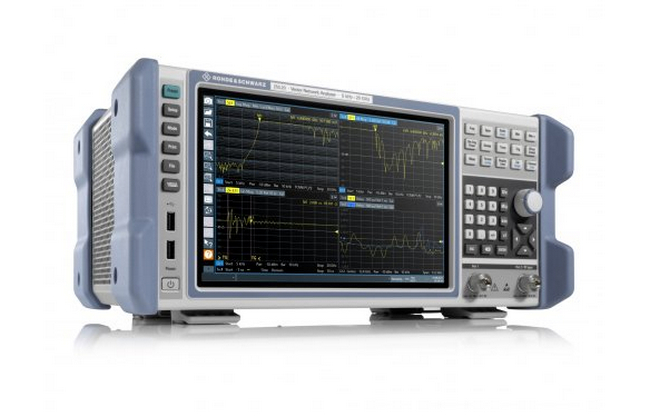 The R&S ZNL20 is one of four new microwave models of the Rohde & Schwarz economy VNAs
The R&S ZNL20 is one of four new microwave models of the Rohde & Schwarz economy VNAs
The new R&S ZNL is ideal for commercial standards of 5 kHz and upwards and can also perform radiated emission measurements that include scans of up to 18 GHz in the time domain to measure voltage standing wave ratios. The R&S ZNL14 and R&S ZNLE14 cover all frequencies in the X band for commercial ground-based and airborne weather monitoring, air traffic control, military satellite transmissions, positioning and target identification.
The R&S ZNL20 and R&S ZNLE18 also support applications measuring in the lower K band (Ku), such as satellite point-to-point communications for GNSS systems, television satellite broadcasts and backhaul links.
Lower frequency models with independent CW source
The R&S ZNL-K14 option is included in the new 1.41 firmware release, expanding the R&S ZNL3, R&S ZNL4 and R&S ZNL6 functions with an internal CW signal generator for DUT stimulation using a continuous wave signal from port 1, while the frequency spectrum is analyzed at port 2. The R&S ZNLx‑B1 spectrum analysis option is required for this function.
The R&S ZNL and R&S ZNLE vector network analyzers are part of the R&S Essentials portfolio. The new microwave models are now available from Rohde & Schwarz and selected distribution partners.
For more information on the R&S ZNL and R&S ZNLE, visit https://www.rohde-schwarz.com/product/znl and https://www.rohde-schwarz.com/product/znle
Rohde & Schwarz
The Rohde & Schwarz technology group is among the trailblazers when it comes to paving the way for a safer and connected world with its leading solutions in test & measurement, technology systems, and networks & cybersecurity. Founded more than 85 years ago, the group is a reliable partner for industry and government customers around the globe. On June 30, 2021, Rohde & Schwarz had around 13,000 employees worldwide. The independent group achieved a net revenue of EUR 2.34 billion in the 2020/2021 fiscal year (July to June). The company is headquartered in Munich, Germany.
R&S® is a registered trademark of Rohde & Schwarz GmbH & Co. KG.
Moxa will help industry connect the d(OT)s at SPS 2021
Visitors to Moxa’s SPS stand will discover how reliable connectivity between sensor and cloud can maximize the potential of OT data in digital transformation projects.
As a leader in industrial networking and communications, Moxa will set the tone for advancing industrial digital transformation at SPS 2021 (23-25 November, Nuremberg, Germany). From stand 231 in hall 9, the company will show how its IIoT solutions ensure secure connectivity and computing between sensor and cloud, helping customers to optimize their digitalization journey.
At present there is a revolution taking place in OT (operational technology) data in order to facilitate industry’s digital transformation. However, due to the exceedingly large OT data sets that need collecting from industrial assets, around 90% of enterprises get stuck at this stage. Moxa’s experience reveals there are four challenges that must be overcome in order for companies to avoid transmitting unusable OT data to an IT system, namely the successful acquisition, preparation, transmission and security of OT data.
For instance, how is it possible to simplify data acquisition, particularly in an industrial world littered with legacy systems such as controllers and data silos? As for data preparation, how can IT systems analyze OT data directly without any context, and how is it possible to achieve true intelligence with slow reaction times? A further challenge relates to data transmission and avoiding the influence of environmental factors. In addition, how can companies ensure that the control data remains top priority as the need for more diverse and real-time data becomes more prevalent? Find out the answers to all of these questions by visiting the Moxa stand at SPS.
Data security is another massive challenge. At the exhibition, Moxa will demonstrate how companies can strengthen industrial cybersecurity and adopt a ‘defense in depth’ approach. The company’s solutions in this area help to unite industrial networks and security, integrate OT/IT perspectives on network protection, and detect and mitigate cyber threats for system integrity.

The value Moxa brings with its connectivity infrastructure solutions is the building of reliable and secure networks that connect all the requirements necessary for successful automation. As a result, it is possible to improve productivity and efficiency in industrial applications that include smart rail, smart grid, intelligent transportation, smart manufacturing, oil and gas, and marine.
The company achieves this highly desirable outcome by collaborating with customers and renowned partners to transform their unique ideas into feasible network solutions. The company works with cloud, software and sensor partners to build a reliable and secure IIoT application, end to end. Moxa IIoT projects are easy, fast and scalable, with a strategy built on two core principles: IIoT projects can only be successful if results are achieved quickly with limited effort; and projects must be designed with the end in mind (large-scale roll-out).
For Moxa, IIoT means making it easy for customers to capture, clean and use data from industrial assets. To illustrate its partner-based approach, the company will stage a live demonstration at SPS. This real life showcase is based on Moxa’s IIoT demo kit, incorporating TeamViewer for remote access, visualization and augmented reality, and Crosser for edge analytics and data connectivity. Be sure to call by the stand to see the demonstration in person.
Adding further visitor value to the SPS experience, Moxa will broadcast expert IIoT webinars from its stand at 11:00 on all three days of the exhibition. Topics will include analytics, machine learning, remote monitoring, and control and maintenance. The webinars will also stream live on Moxa’s event platform.
Of course, SPS visitors are also invited to speak directly with Moxa’s team of friendly expert professionals about their specific applications and challenges. Plenty of knowledge and expertise will be on-hand at the show. With over 30 years of experience in connectivity for industrial automation, Moxa has reliably and securely connected more than 71 million devices worldwide.
Find out more at: https://moxa-europe.com/sps
Wood Thilsted complete design, transport and installation work for Akita Noshiro, Japan
After gaining the prestigious detailed design contract for ScottishPower Renewables’ East Anglia Hub in England, Wood Thilsted has now completed secondary steel design for Japan’s first commercial windfarm, Akita Noshiro Offshore Wind, on the far north west coast of Honshu.
Wood Thilsted is also providing the Kajima Corporation (part of the EPCI contractor) with transport and installation (T&I) support for Akita Offshore Wind Corporation, whose inaugural project, comprising 33 turbines, is expected to commence energy generation in late 2022.
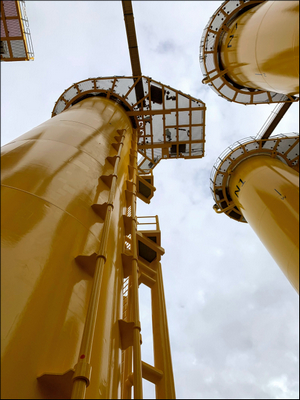 Danny Bonnett, Engineering Director at Wood Thilsted, said: “Design work, transport and installation assessments for an emerging technology in a new market always provides a series of particular challenges, including the interpretation of relevant health and safety regulations.”
Danny Bonnett, Engineering Director at Wood Thilsted, said: “Design work, transport and installation assessments for an emerging technology in a new market always provides a series of particular challenges, including the interpretation of relevant health and safety regulations.”
“But”, he added, “as we are already achieving in Taiwan and other locations worldwide, our experts can deliver a highly efficient and ergonomic design arrangement that meets specific needs; in this case, designing secondary structures, including important boat-landing and external work platforms for a part of the world where seismic events can cause high wave loading”.
The Akita Noshiro project has a conical grouted connection, which for the installation scope, required careful work to ensure that the ‘centralisers’ and associated jacks would ensure accurate levelling of transition pieces, whilst providing enough fixity during grout curing to mitigate the effects of early age cycling.
Developed by a consortium led by Marubeni, the Akita project
maintained a very challenging schedule for manufacture, transportation and installation works; in part by Wood Thilsted’s experience of the type of turbines that have been installed - and its understanding of the requirements for support and installation of high voltage electrical components.
In addition to this first commercial windfarm in Japan, Wood Thilsted has also provided detailed design for both Vineyard Wind (the first utility-scale offshore windfarm in America) and for Dogger Bank A in the North Sea (UK).
Seeq Announces Expanded Microsoft Azure Machine Learning Support
New Seeq Azure Add-on feature enables rapid deployment of Azure Machine Learning algorithms to frontline plant employees.
Seeq Corporation, a leader in manufacturing and Industrial Internet of Things advanced analytics software, announced today additional integration support for Microsoft Azure Machine Learning. This new Seeq Azure Add-on, announced at Microsoft Ignite 2021, an annual conference for developers and IT professionals hosted by Microsoft, enables process manufacturing organizations to deploy machine learning models from Azure Machine Learning as Add-ons in Seeq Workbench. The result is machine learning algorithms and innovations developed by IT departments can be operationalized so frontline OT employees can enhance their decision making and improve production, sustainability indicators, and business outcomes.
Seeq customers include companies in the oil & gas, pharmaceutical, chemical, energy, mining, food and beverage, and other process industries. Investors in Seeq, which has raised over $100M to date, include Insight Ventures, Saudi Aramco Energy Ventures, Altira Group, Chevron Technology Ventures, and Cisco Investments.
Seeq’s strategy for enabling machine learning innovations provides end users with access to algorithms from a variety of sources, including open source, third party and internal data science teams. With the new Azure Machine Learning integration, data science teams can develop models using Azure Machine Learning Studio and then publish them using the Seeq Azure Add-ons feature, available this week on GitHub. Using Seeq Workbench, frontline employees with domain expertise can easily access these models, validate them by overlaying near real-time operational data with the model results, and provide feedback to the data science team. This enables an iterative set of interactions between IT and OT employees, accelerating time to insight for both groups, while creating the continuous improvement loop necessary to sustain the full lifecycle of machine learning operations.
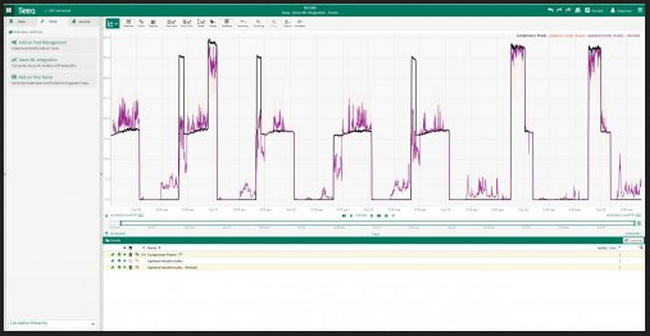
“Seeq and Azure Machine Learning are critical and complementary solutions for a successful machine learning model lifecycle,” says Megan Buntain, Director of Cloud Partnerships at Seeq. “By capitalizing on IT and OT users’ strengths, the Seeq Azure Add-on expands the Seeq experience and creates new opportunities for organizations to scale up model deployment and development.”
Along with increased access to machine learning models through this integration, Seeq’s self-service applications enable frontline employees to perform ad hoc analyses and use the models themselves, rather than rely on an IT team member for support. As the models yield results, Seeq empowers users to scale them across the organization to improve asset reliability, production monitoring, optimization, and sustainability.
In addition to launching the Azure integration, Seeq is also expanding its list of published open source algorithms this week with the addition of a new Seeq Add-on to GitHub for multivariate pattern search. Seeq’s open source gallery also includes algorithms and workflows for correlation and clustering analytics, which users can modify and improve based on their own needs.
Seeq has been available as a SaaS application in the Azure Marketplace since 2019, with support for many Azure cloud services including Synapse, Azure Data Lake, and Active Directory. Seeq also supports connectivity to Azure Data Explorer, Time Series Insights, and Power BI.
Seeq is available worldwide through a global partner network of system integrators, which provides training and resale support for Seeq in over 40 countries, in addition to its direct sales organization in North America and Europe.
To learn more about Seeq visit seeq.com.
Welltec® launches new Well Tractor®
Welltec’s all-new Continuous Variable Tractoring (CVT) solution builds on a pioneering conveyance heritage to once again transform well interventions.
Welltec® has launched a fully revised and transformed design of the pioneering Well Tractor® conveyance solution: Well Tractor® 212 CVT, equipped with Continuous Variable Tractoring technology. The new CVT system automatically maximizes speed and power at all times, optimizing every conveyance run, making operations faster and more efficient than ever before.
Commenting on the launch of the CVT, Welltec VP Sales & Marketing, Alex Nicodimou said: “The Well Tractor remains a key service that we provide, it’s the foundation of everything that we do in conveyance and a solid base for our powered mechanical interventions platform. It’s what started the entire domain of interventions on wireline.”
“Now our engineers are bringing something special to the market that will ensure we continue to lead in conveyance solutions.”
In addition to the new Continuous Variable Tractoring system, the new Well Tractor offers a whole host of innovative functionality and performance features, including a heavily revised electronics package that is rated to higher temperature demands within a more robust architecture. It also allows for full two-way surface control, that can send commands to the tool downhole and receive diagnostics back at surface.

Traditional conveyance platforms are driven hydraulically by a pump, and in many cases, that downhole hydraulic pump is a shared asset that powers multiple wheel sections downhole. The Well Tractor CVT is configured so that each wheel section has its own power unit. These new hydraulic units and wheel sections are shorter and more powerful than ever before, resulting in a system that operates as multiple individual tractors downhole with inherent redundancy, without compromising on overall length. In the event that any one section meets a restriction of any kind, the other sections remain free to power themselves without any detrimental effect.
Well Tractor CVT is the next phase in development of Welltec’s conveyance technology – building on more than 25 years of knowledge and experience, it promises to be just as transformative as the original.
About Welltec
Welltec® is a global technology company that develops and provides efficient hi-tech solutions for the energy industry. The company’s cutting-edge products and services are designed to optimize well performance and well integrity in all environments. Through advanced engineering and lightweight design, Welltec’s solutions have been helping clients reduce environmental emissions and carbon footprints in a safe and sustainable way for more than 25 years.
